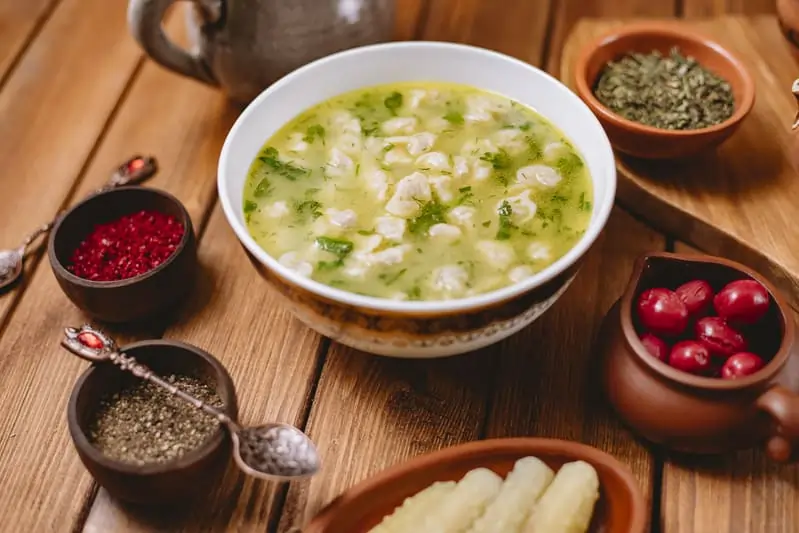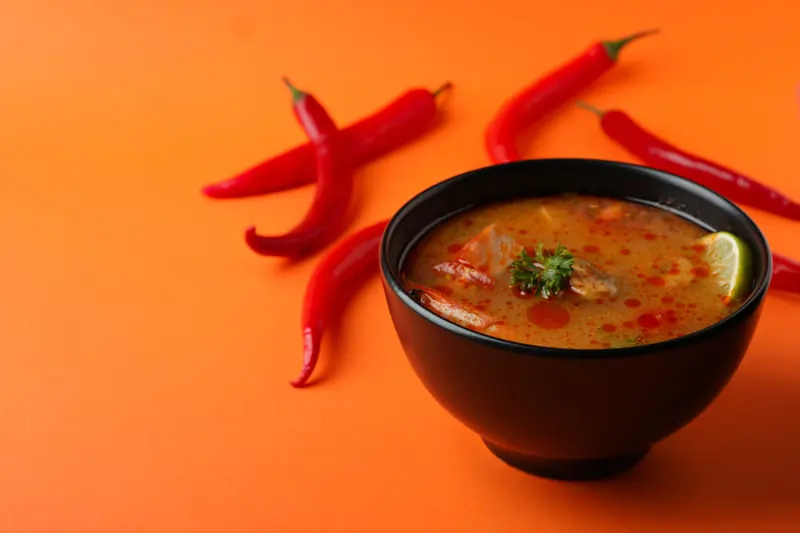Chili, in all its forms, is a beloved comfort food around the world—celebrated for its warmth, richness, and versatility. While many are familiar with traditional, tomato-based chili known for its bold flavors and spicy kick, fewer have explored the subtle, creamy appeal of white chili. Though both dishes serve the same hearty purpose, they differ notably in ingredients, taste profiles, and cooking techniques.
White Chili vs. Regular Chili: What Sets Them Apart
The primary distinction between White chili vs regular chili lies in their ingredients. Chili Differences: White chili uses white beans, poultry, and often a cream-based sauce. Regular chili includes red kidney beans, ground beef, and a tomato base. These foundational differences affect their textures, flavors, and nutritional values.
Explore additional creamy dishes like vegan white bean chili for more comforting meal ideas.
White Chili vs Regular Chili, the origin.
Origins
White Chili: A newer culinary innovation, white chili originated in the Southwestern United States during the 1980s. It emerged as a milder alternative to traditional chili and quickly became popular for its unique flavor and lighter profile.
Regular Chili: Rooted deeply in Tex-Mex traditions, regular chili has been a beloved dish in Mexican and Texan cuisines for generations. Known for its hearty and robust flavors, it remains a staple comfort food across various regions.
White chili vs regular chili. Key Ingredients.

White Chili:
- Beans: Great northern or cannellini beans are favored for their mild flavor and creamy texture. These qualities make them ideal for the subtle taste of white chili.Protein: Lean poultry, such as chicken or turkey, is commonly used. It provides a healthier protein option that complements the lighter broth.Broth and Spices: The dish uses a base of chicken broth. It is infused with spices like cumin, coriander, and oregano, which add depth and warmth.Creamy Elements: Cream or sour cream is stirred in before serving. This gives the chili a velvety finish that beautifully balances the mild heat.
- Chilies: Mild green chilies are incorporated to introduce a gentle heat without overpowering the other delicate flavors.
Regular Chili:
- Beans: Red kidney beans or pinto beans are the foundation, offering a hearty texture and earthy taste.
- Meat: Ground beef or pork adds rich, savory flavors that are quintessential to the classic chili experience.
- Tomato Base: A tomato-based sauce provides acidity and moisture, binding all the ingredients together.
- Spices: A blend of spices such as chili powder, paprika, and garlic creates a vibrant flavor profile that is both spicy and aromatic.
- Additional Vegetables: Ingredients like diced tomatoes, onions, and bell peppers are often added for extra flavor, texture, and nutrition.
Flavor Balancing Guide: For those interested in learning how to effectively balance flavors and ingredients, consider exploring our guide on making banana bread with fewer ingredients. This guide provides practical tips and simple adjustments for creating delicious banana bread. It ensures that even novice bakers can achieve great results. Understanding how to manage and balance your ingredients is key to culinary success, whether you’re making chili or banana bread.
White chili vs regular chili, how Do tehy Differ in Cooking Techniques?
The cooking methods for these White chili vs regular chili are carefully chosen to enhance their distinct ingredients and flavors:
White Chili:
- Simmering the Poultry: Start by simmering poultry, such as chicken or turkey, in chicken broth. Add spices like cumin, coriander, and oregano early in the cooking process, allowing them to infuse the broth with their flavors while the poultry becomes tender and juicy.
- Combining Ingredients: Once the poultry is cooked, blend in white beans and mild green chilies. The final touch involves stirring in cream or sour cream, which melds all the components into a smooth, creamy texture. This method not only thickens the chili but also tempers the spices, resulting in a comforting and hearty bowl that’s not too overpowering.
Regular Chili:
- Building the Base: Begin by sautéing ground beef with onions and garlic. This foundational step is crucial as it develops a deep, rich flavor base. The meat should be browned thoroughly to unlock its savory potential, while the onions and garlic should become aromatic and golden.
- Adding Depth: Following the sauté, introduce beans, tomato sauce, and a hearty mix of spices such as chili powder, paprika, and garlic. Allow the mixture to simmer. This slow cooking process melds the flavors beautifully, creating a robust and hearty dish that epitomizes traditional chili.
Flavor Profiles: Comparing White Chili to Regular Chili
Exploring the distinct characteristics of both white and regular chili reveals how each dish caters to different palates and preferences:
White Chili:
- Mild and Creamy: The base of white chili is notably milder compared to its traditional counterpart. It features a creamy consistency that’s slightly tangy, providing a soothing and rich culinary experience. This creaminess is primarily derived from the addition of cream or sour cream, which softens the overall heat and spices.
- Subtle Spiciness: The spice level in white chili is kept subtle, with green chilies adding just a hint of heat. This mild spice is perfectly balanced with the earthy tones of cumin and the citrus-like zest of coriander, creating a complex yet understated flavor profile that appeals to those who prefer gentler spices.
Regular Chili:
- Bold and Tomato-Forward: Regular chili presents a bold flavor that’s led by a tomato-forward base. This robust foundation is key to its vibrant taste and rich, saucy texture, which encapsulates the essence of traditional chili.
- Hearty Texture: The texture of regular chili is chunky and hearty, featuring well-cooked beans and ground meat that provide a satisfying chew. The pronounced spice from chili powder, along with additional spices like paprika and garlic, contributes to its intense and hearty flavor profile, making it a favorite for those who enjoy a more substantial dish.
For a deeper exploration into how to balance and enhance the flavors in your cooking, consider reading our guide on creating flavor profiles that cater to various dietary preferences. Whether you’re aiming for the subtle tanginess of white chili or the bold richness of regular chili, understanding these elements can significantly elevate your culinary creations.
Nutritional Value Comparison
When comparing the nutritional content of white chili and regular chili, each offers unique benefits suited to different dietary needs and health goals:
White Chili:
- Calories and Fat: White chili is generally lower in calories, containing approximately 200 calories per serving, with around 6 grams of fat. This makes it a lighter option, particularly suitable for those monitoring their calorie intake.
- Protein Source: The inclusion of poultry, such as chicken or turkey, provides a substantial amount of lean protein, which is crucial for muscle repair and overall health.
- Fat Content: Although cream is added to white chili, which introduces some saturated fats, it significantly enhances the flavor and texture of the dish, making it rich and enjoyable while still maintaining a relatively low fat content compared to richer dishes.
Regular Chili:

- Higher Caloric Content: With about 350 calories per serving and 15 grams of fat, regular chili is more calorie-dense, primarily due to the inclusion of ground beef or pork. This higher fat content contributes to a richer flavor and more satisfying meal.
- Protein-Rich: Despite its higher fat content, regular chili is also rich in protein, thanks to the beef or pork, supporting body functions and providing a longer-lasting sense of fullness.
- Nutritional Additions: The tomato-based sauce not only adds a depth of flavor but also contributes vitamins and antioxidants, which are beneficial for overall health and help combat oxidative stress.
Both dishes have their place in a balanced diet, depending on individual health goals and dietary preferences. For those interested in further exploring the health benefits of different types of proteins or the role of antioxidants in your diet, our detailed article on nutrition in homemade meals provides comprehensive insights and practical tips to help you make informed dietary choices.
Serving Suggestions and Pairings
Each type of chili offers a unique flavor that can be enhanced with thoughtful pairings and toppings:
White Chili:
- Toppings: Enhance the mild and creamy base of white chili with toppings like shredded cheese, which adds a melty richness; jalapeños, introducing a spicy kick; and green onions, which provide a crisp, fresh contrast.
- Pairings: Serve white chili with sides that complement its lighter profile. Cornbread is a classic choice, offering a sweet, buttery flavor that pairs beautifully with the chili. Alternatively, a side of rice can absorb the chili’s flavors, creating a satisfying meal. Crackers also make a great pairing, offering a crunchy texture that contrasts well with the creaminess of the chili.
Regular Chili:
- Toppings: Regular chili pairs well with rich and flavorful toppings. Sour cream adds a cooling touch to balance the spice, diced onions bring a sharpness that cuts through the richness, and shredded cheddar melts into the chili for added decadence.
- Pairings: For a heartier meal, serve regular chili with Fritos or tortilla chips, which add a satisfying crunch and salty flavor that complements the boldness of the chili. A cold beer is another excellent pairing, as its crispness refreshes the palate between bites of this spicy dish.
For more creative side dish ideas, explore our collection of unique bread options that can serve as the perfect complement to any chili. From garlic bread to artisan rolls, each type of bread can enhance the dining experience, providing a delightful textural contrast and flavor enhancement to the robust tastes of chili.
Popular Variations
Exploring the popular variations of both white and regular chili can help you cater to diverse taste preferences and dietary needs:
White Chili Variations:
- Southwestern-style White Chili: Amp up the traditional white chili by adding extra green chilies. This variation introduces more heat, making it ideal for those who enjoy a spicier dish while still retaining the creamy base that white chili is known for.
- Vegetarian White Chili: For a plant-based option, consider a vegetarian white chili that uses a mix of beans and cauliflower instead of meat. This version not only maintains the creamy consistency but also adds a variety of textures and flavors, enriching the dish without the use of animal products.
- Turkey-based White Chili: Incorporate lean turkey into your white chili for a healthier protein alternative. Turkey is lower in fat than many other meats, making this version a great choice for those looking to enjoy a hearty meal without too much fat.
Regular Chili Variations:
- Spicy Chili: For those who love heat, create a spicy version of regular chili by adding generous amounts of cayenne pepper and hot peppers. This fiery twist is sure to satisfy spice enthusiasts, adding an intense kick to the traditional flavors.
- Beanless Chili: Focusing solely on meat and spices, a beanless chili caters to those who prefer a low-carb option or simply enjoy a denser, meatier dish. This variation highlights the rich flavors of the meat and is often popular in keto diets.
- Vegetarian Chili with Lentils or Black Beans: Swap out meat for lentils or black beans to create a vegetarian chili that’s both satisfying and nutritious. Lentils offer a meaty texture and are an excellent protein source, while black beans bring a classic chili feel to the dish, making it a fulfilling alternative for vegetarians.
FAQs
What are the main ingredient differences white chili vs regular chili.
White chili uses white beans, poultry, and a creamy base, while regular chili incorporates red beans, beef, and tomato-based sauces.
Which is spicier?
Regular chili is generally spicier due to chili powder and hot peppers, while white chili is mild with optional heat from green chilies.
Can you substitute ingredients between white chili vs regular chili?
Yes, you can swap beans or proteins, but the base sauces (cream vs. tomato) significantly affect the flavor.
Which is better for weight loss?
White chili, with its lower fat content and lean protein, is often the lighter choice.
For more creative recipe insights, explore ingredient hacks for baking.
Conclusion: Which Chili is Right for You?
Choosing between white chili and regular chili ultimately comes down to personal taste and dietary preferences. If you enjoy bold, spicy flavors, traditional chili might be your go-to. For those who prefer a milder, creamier dish, white chili offers a comforting alternative. Both versions are flavorful, adaptable, and satisfying in their own way. Don’t hesitate to experiment with ingredients and spices—exploring both styles can help you discover your ideal bowl of chili.

